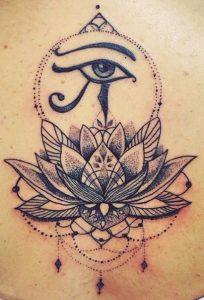Egypt is the cradle of tattoo art. Several mummies exhibiting Egyptian Tattoos art forms have been recovered from ancient Egypt. One of the most famous of those early mummies is that of Amunet, a priestess of the goddess Hathor, who was found at Thebes.

Her remains display several intricate lines and dots tattooed on her body in a common religious design. Egyptian Tattoos were present in several female mummies dated to c. 2000 B.C.
Most examples on mummies are largely dotted patterns of lines and diamond patterns, while figurines sometimes feature more naturalistic images. Usually, a dark or black pigment such as soot was introduced into the pricked skin. Tattoos were very popular among Egyptian women.
Egypt had strong beliefs about afterlife which the modern society may find difficult to digest. They ascribed to the tattoo the power to connect the bodies to the divine. The tattoo was also a talisman or a permanent amulet that cannot be lost. It provided magical and medical protection.
Egyptian Tattoos Represents God Bes
The earliest known Egyptian Tattoos with a picture of something specific represents the god Bes. Bes is the lascivious god of revelry and he served as the patron god of dancing girls and musicians. Bes’s image appears as a tattoo on the thighs of dancers and musicians.
Ankh tattoos
Ankh tattoos, for example, consist of an ancient symbol that’s imbued with magical protection. The ankh is a cross symbol that predates the Christian cross by several thousand years.
The Ankh Cross looks like the Latin cross with a rounded component at the top of the cross. It is the hieroglyphic symbol for ‘life’. Like other ‘symbol’ tattoos, ankh tattoos look good on an ankle, upper arm or shoulder.
Eye of Horus
Eye of Horus was a popular Egyptian art tattoo. The Eye of Horus is a protection symbol. The symbol was used on ships, amulets, bracelets, etc. Horus was the god of the sky and looked like a falcon. The eye is the right eye of the falcon. The markings under the eye represent a teardrop.
In ancient Egyptian mythology, Anubis is the god of the dead. He has the body of a man and the head of a jackal. In one hand he wears an ankh cross, in the other a stick. Anubis tattoos symbolize protection from death.
Mummy Tattoos
There were also Mummy tattoos and Scarab tattoos: the scarab, dung beetle and the embodiment of the god called Khepri, was worshipped in ancient Egypt. It was believed a scarab rolled the sun through the sky, just like a dung ball.
It is assumed that a sharp point set in a wooden handle, dated to c. 3000 B.C. may have been used to create tattoos. A set of small bronze instruments resembling wide, flattened needles has also been discovered which if tied together in a bunch would provide repeated patterns of multiple dots.
Egyptian tattoos remain popular, striking powerful images of the ancient past. In the modern world, tattoos have become socially acceptable especially among the youth.